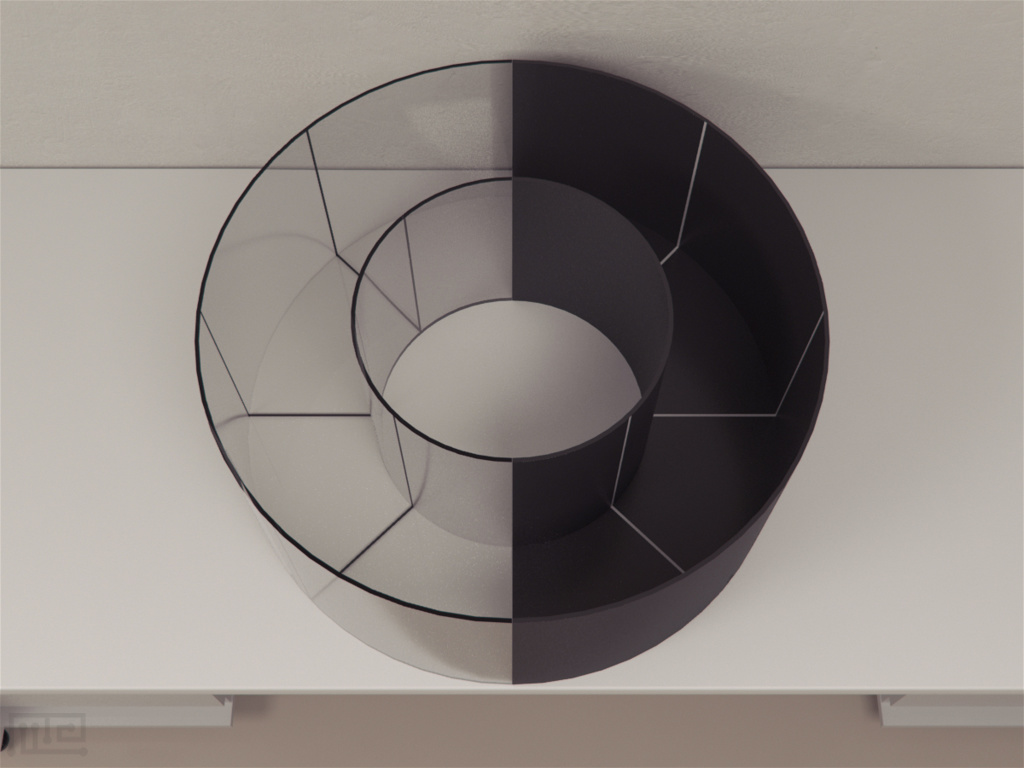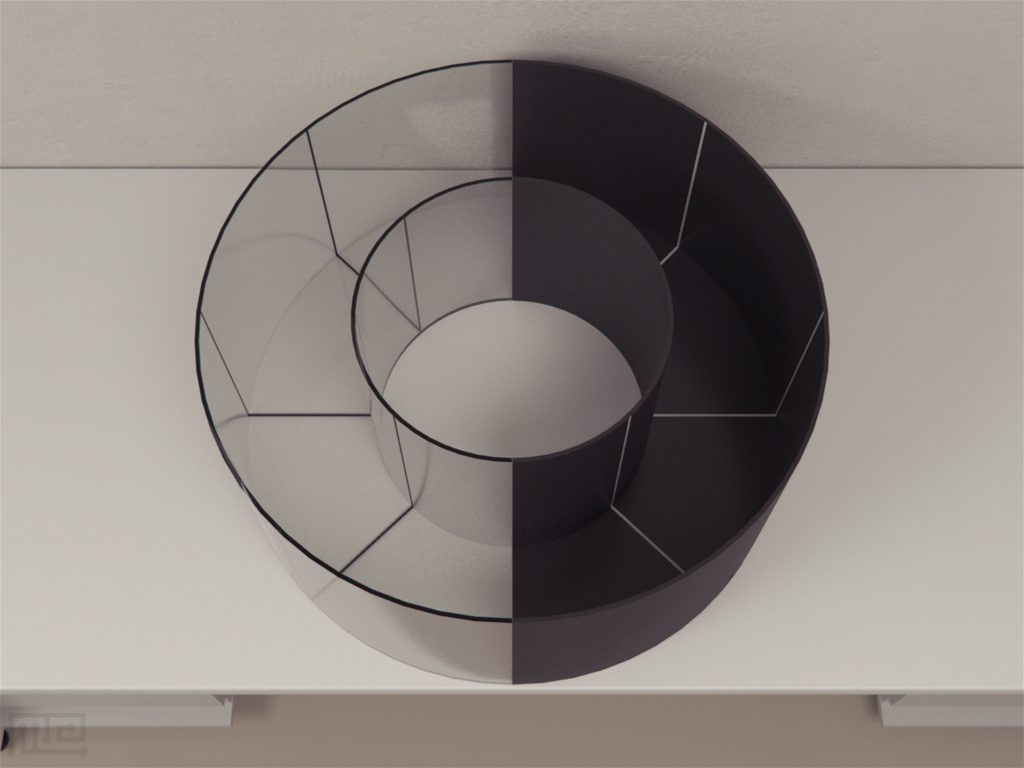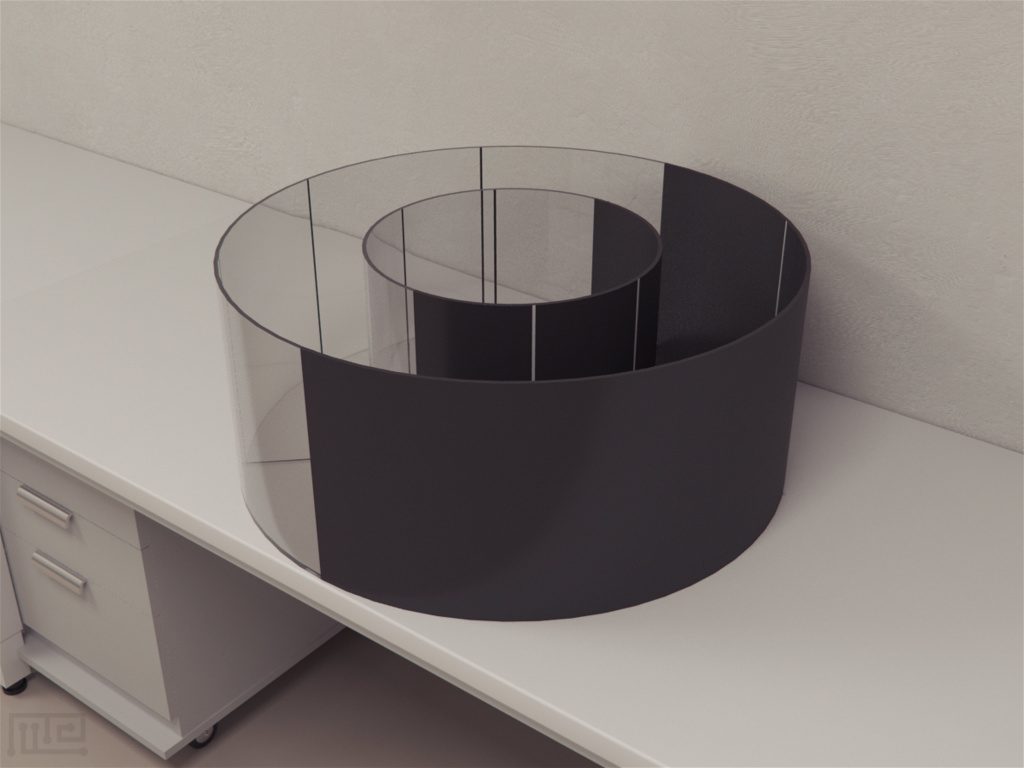The Circular Light-Dark box (CLDB) consists of a circular alley with an inner and outer wall that is a variant of the light dark box. It is designed to assess the effects of anxiety and fear preferences between light and dark areas. Given a choice, rats prefer to stay in the unlit areas rather than the lit areas.
Price & Dimensions
Mouse
$ 1800
+S&H- Inner wall diameter: 28 cm
- Outer wall diameter: 55 cm
- Wall height: 23 cm
Rat
$ 1900
+S&H- Inner wall diameter: 43 cm
- Outer wall diameter: 83 cm
- Wall height: 35 cm
Josef van der Staay F, Schuurman T, G van Reenen C, Korte M. Emotional reactivity and cognitive performance in aversively motivated tasks: a comparison between four rat strains. Behavioral and Brain Functions 2009, 5:50
Documentation
Introduction
Circular Light Dark Box (cLDB) is a behavioral task that provides a measure of emotional reactivity. It is an aversively motivated memory and learning task that triggers and records anxiety in subjects. It is based on the principle that emotion and cognition are closely related and given a choice, the anxious subject will prefer the unlit area of the task environment.
Circular Light Dark Box is developed by Josef, Teun, Cornelis, and Mechiel (2009). It is a variant of Light Dark Box that is used to test anxiety-like behaviors in rodents. cLDB is used to study the effects of anxiolytic drugs, such as those that reduce serotonin (5-hydroxytryptamine or 5-HT) function in the body.
cLDB consists of a black and white circular box where subjects are placed in groups. The proportion of time spent in both light and dark compartments is recorded.
Apparatus and Equipment
cLDB consists of a circular apparatus with an inner and outer alley; half of which is black and the other half is transparent. Both the inner and outer wall are 350mm high and have diameters of 430mm and 830mm respectively.
Just outside the inner transparent wall are fitted three 50-watt halogen bulbs to provide a light intensity of 800lux and 5lux in light and dark compartments respectively. There are placed in equally spaced segments in both light and dark compartments.
The whole apparatus is made of hard plastic called polyvinyl chloride (PVC).
Training Protocol
House the animals in pairs with ad libitum supply of food and water. Maintain day-light cycle, room temperature and humidity at 12/12, 20ºC and 60% respectively. A camera (Noldus Etho Vision® XT) can be mounted overhead to record the movement and calculate scores. Clean the apparatus with a damp sponge at the start of the experiment and after every test.
Assessment of Emotional Reactivity
Randomly assign animals to the light and dark compartments of cLDB in a way that half of the group populates the light compartment, and the remaining half goes in the dark compartment. Record and monitor locomotion and emotional reactivity for a total of 5 sessions spanned over 3 consecutive days. Each session lasts 5 minutes.
Analysis of Behavior and Cognitive Performance in cLDB
Josef et al. (2009) recruited four strains of male rats; Lewis, Brown Norway (BN), Wistar Kyoto (WKY) and Fischer (F344). All rats were about 3 months of age and differed in terms of emotional reactivity, endocrinal and serotonergic measures and motivated learning and memory. None of the rats had a mental or physical abnormality that could affect the result.
The rats were kept in cages in pairs and acclimated to the animal facility for 2 months. At the age of 5 months, four emotional reactivity tests were carried out; Open field (OF), Elevated Plus Maze, cLDB, and Morris Water Escape Task (MWET).
All four strains of rats behaved differently in each task; BN had a good performance in MWET whereas F344 behaved poorly. In cLDB, WYK and Lews rats preferred spending more time in the dark compartment as compared to F344 and Lewis rats. The number of line crossings averaged in all four tasks, but grooming bouts of strains differed greatly in all tasks. The researchers calculated the performance score and found no consistency or connection between emotional reactivity and cognitive performance.
Data Analysis
Following animal behaviors are noticed during the task:
- Line crossing: When the subject steps over the line with both hind legs.
- Compartment Entry: When the subject moves from one compartment to another with both hind legs.
In addition, the following five measures are analyzed:
- Defecation: Number of fecal boli eliminated
- Passive avoidance: Time spent in the dark compartment
- Total distance moved
- Number of grooming bouts
- Number of rearings and leanings
Strengths and Limitations
Strengths
cLDB is not a spatial task like like Morris Water Maze and Heat Maze and therefore does not have spatial clues embedded in the box to prompt or force the animal to move towards the escape zone. The stress induced by such tasks is known to affect the performance of the subject. cLDB has a sharp transition from the light to the dark compartment which facilitates easy scoring of dark preference or light avoidance.
Some tasks used in rodent studies, such as Elevated Plus Maze, have small doors that separate lit from the unlit areas (Kabbaj, Devine, Savage, & Akil, 2000; Mombereau et al.2004). A lack of such spatial cues makes cLDB a better, easy-to-handle and feasible tool to measure anxiety-like behaviors.
Both light and dark compartments in cLDB are of equal size. This facilitates comparison of locomotor activity in both.
Compared to other emotional reactivity assessment tasks, such as OF-EBM-LDB, cLDB is less prone to noise, environment and test conditions.
Limitations
While cLDB is a reliable tool to measure emotional reactivity, its generalizability and universality are dubious. There is a great degree of performance variation between different rat strains; WYK and Lewis rat strains prefer dark compartment as compared to F344 and BN. However, if defecation is considered the index of emotional reactivity, then BN and F344 appear most anxious. cLDB is either less effective in measuring emotional reactivity in these strains or may affect emotionality in these strains more.
In either case, the strains have to be re-tested repeatedly before the translational value of findings can be authenticated.
Summary
- Circular Light Dark Box is a behavioral task to measure emotional connectivity in rats.
- Animal experiments provide insight into neurobiological mechanisms such as learning and memory.
- cLDB is used to assess the relationship between anxiety and light avoidance.
- It is based on the principle that emotional reactivity controls cognitive functions.
- The apparatus consists of a circular box with light and dark compartments.
- Animals with higher levels of stress and anxiety will evade light and crawl into the dark compartment.
- The locomotive scores are calculated, and the conclusion is drawn.
References
- Korte S.M, Schuurman, T., Staay, F.J., & van Reenen C.G. (2009). Emotional reactivity and cognitive performance in aversively motivated tasks: a comparison between four rat strains. Behav Brain Funct, 5, 50. http://dx.doi.org/10.1186/1744-9081-5-50
- Akil, H. Devine, D.P., Kabbaj, M., & Savage, V.R. (2000). Neurobiological correlates of individual differences in novelty-seeking behavior in the rat: differential expression of stress-related molecules. J Neurosci, 20(18), 6983-6988
- Cryan, J.F., Froestl, W., Kaupmann, K., Mombereau, C., Sansig, G., & van der Putten H. (2004). Genetic and pharmacological evidence of a role for GABAB receptors in the modulation of anxiety- and antidepressant-like behavior. Neuropsychopharmacology, 29(4), 1050-1062. http://dx.doi.org/10.1038/sj.npp.1300413




